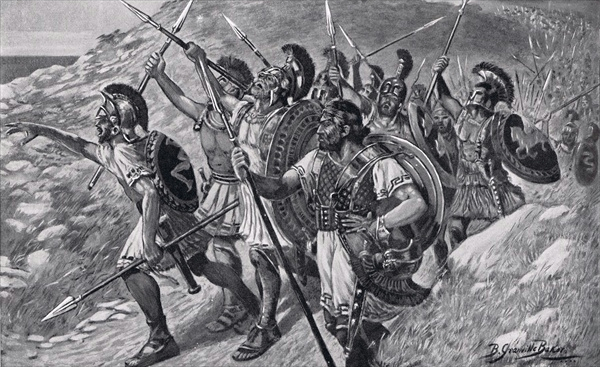|
Bernard Granville Baker
Bernard Granville Baker (23 October 1870 – 12 March 1957) (known as B. Granville Baker) was a British soldier and painter specialising in military subjects. He wrote and illustrated a number of books. Life and work Baker was born in Pune (then called Poona) in India. He was the son of Montagu Bernard Baker, who worked for the British East India Company, and his wife Harriet Fanny Bangh. He was educated at Winchester College and the Military Academy at Dresden. He served in th21st (Empress of India's) Hussarsin India and Burma. He fought in the Boer Wars in South Africa in 1900. In the First World War, he became a Lieutenant-Colonel and commanded a battalion of the Yorkshire Regiment. He was awarded the Distinguished Service Order in 1918. Baker is known for his illustrations and watercolour paintings of military subjects, such as "Sir John Moore at Corunna, January 16th 1809" in the 1920s. He exhibited his paintings at Liverpool's Walker Art Gallery and the Lon ... [...More Info...] [...Related Items...] OR: [Wikipedia] [Google] [Baidu] |
10000-03
1 (one, unit, unity) is a number representing a single or the only entity. 1 is also a numerical digit and represents a single unit of counting or measurement. For example, a line segment of ''unit length'' is a line segment of length 1. In conventions of sign where zero is considered neither positive nor negative, 1 is the first and smallest positive integer. It is also sometimes considered the first of the infinite sequence of natural numbers, followed by 2, although by other definitions 1 is the second natural number, following 0. The fundamental mathematical property of 1 is to be a multiplicative identity, meaning that any number multiplied by 1 equals the same number. Most if not all properties of 1 can be deduced from this. In advanced mathematics, a multiplicative identity is often denoted 1, even if it is not a number. 1 is by convention not considered a prime number; this was not universally accepted until the mid-20th century. Additionally, 1 is the ... [...More Info...] [...Related Items...] OR: [Wikipedia] [Google] [Baidu] |
Guido Elbogen
Guido Elbogen (1845–1918) was an Austrian banker and mathematician who became President of the Anglo-Austrian Bank. Early life He was born into a Jewish family on 27 December 1845 in Jungbunzlau (now Mladá Boleslav) in Bohemia. Jungbunzlau, which was then in the Austrian Empire, is now Mladá Boleslav in the Czech Republic. Of the children of Rabbi Isak Elbogen (1812–1883) and his wife Friederike (''née'' Pokorny; 1825–1906) he was the only one to survive beyond infancy. Career After studying at the Academy of Commerce in Prague, Elbogen entered the banking business at the Ladenburg Bank in London, before moving to Paris where he joined Oppenheim, Alberti and Co, working to Antoine Schwabacher whose daughter Rosalie he married in 1868. In 1874 a lampooning cartoon of him appeared on the front cover of an issue of the French satirical newspaper '' Comic-Finance'', which also included a biographical piece by the newspaper's editor Ernest Schrameck, writing under the p ... [...More Info...] [...Related Items...] OR: [Wikipedia] [Google] [Baidu] |


